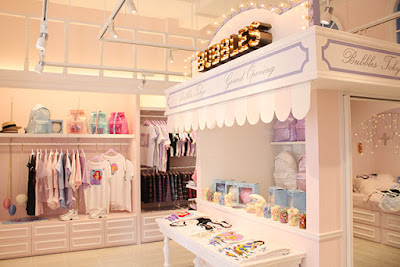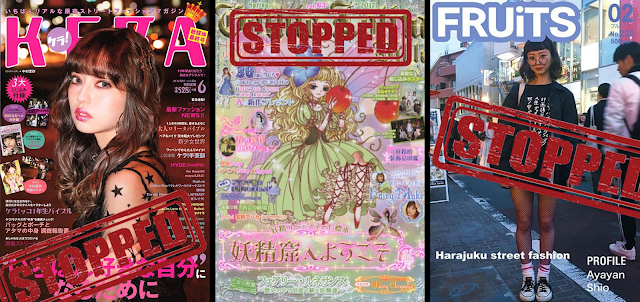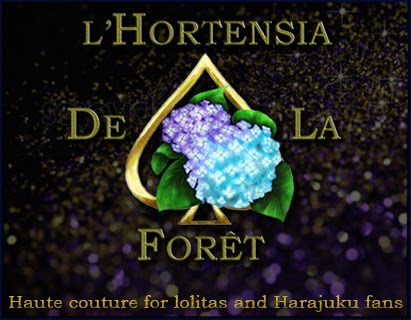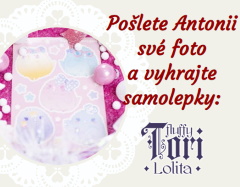Coffee time: Is Harajuku dead or what?
First of all, no, Harajuku fashion is NOT dead.
I repeat.
HARAJUKU FASHION IS NOT DEAD!
Repeat 'till hoarse.
Put that mourning outfit back into your wardrobe.
(Before you read: I am not gonna talk about the birth of Harajuku fashion or it's history - the earliest or more modern, I am just gonna write why everybody panics and why is the fashion changing. I am assuming you are familiar with certain milestones and with the relationship between the fashion itself and Japanese political/cultural history. There will be separate series that will focus on the history.)
Let's just state some facts, shall we?
- FRUiTS magazine is over
- Kera is continuing digitally, their shop is still open
- Gothic&Lolita bible is over
- Eternita has been born
- Melt has been born
- Tourists are cancer. Seriously, we will talk about this later, but they are horrendous
- Some shops have closed down
- Several new fashion styles have emerged
- Some trends are worn by a minority
- Fast fashion is a natural disaster but people buy it
FRUiTS magazine is dead, but FRUiTS lives on. At least, Aoki Shoichi said so (If you don't know who that is, he is the dude that gave birth to the cult, the photographer that should be worshipped by every fashionista). That guy still takes photographs, and besides, FRUiTS lives on in everyone who wears Harajuku fashion. Thanks to those pages full of amazingly dressed people, Harajuku fashion got around like a plague. History is documented on those pages! One day, that stuff will be in museums because once it was an incredible monthly occurrence of stylish. Now, you don't have that because everyone has instagram and so instead of once a month, people can have eye orgasms every minute.
You know, publishing a magazine, a monthly magazine at that, is not cheap. You have advertisements, staff, printing. It's not cheap. And people just don't buy physical copies anymore.
 |
| Aoki Shoichi. Source here |
Thus, let me ask you a question. When was the last time you bought a PRINTED magazine/book/fashion spread? Yeah, a majority of people doesn't buy that anymore, right? The truth is, we live in a digital world, everything you need is made up of zeros and ones, not lignin and cellulose. Someone wants to see the latest fairy kei fashion trends? They search tumblr. Someone else want to know what their favourite star said? They don't read a printed interview, they check their twitter.
And that is not a bad thing, everything is easier to access, you want a tour of Harajuku? Well then have a damn virtual tour of Harajuku! The thing is, three magazines ceased their printed production, other just started, some went digital. That does not mean that Harajuku fashion magazines are over, they evolved into either digital form or morphed - I like to think of Melt as a love child of Kera and G&L Bible. Individually, those two magazines didn't have a large audience, but together? I have hope~
 |
| Kera mobile, issue 9. Have a look at it, it's just as awesome as were the printed issues! |
 |
| It's interesting that even though tourism in Japan is on decline, Harajuku still has the same problem with number of tourists for the past, let's say five/four years. Source |
We are getting older. I mean, majority of the friends I've made over the years is in their late 20s and are getting jobs, having families and just generally do the scary thing called growing up. The younger generation obviously doesn't have the same tastes as we did. Their fashion is new, fresh and there is obviously that sibling-like relationship with fast fashion and mainstream trends. Harajuku fashion is still there just in another form. Trends have been born and dead and it's life of the fashion industry. What was is in the past, you can't have the same fashion trends in the same form existing, like, for all eternity. That's like with people and evolution (even though I think that evolution is chronically afraid of some beings and ran away from them while they were in the form of zygota.). I am sure that there will be born more dark and visual-like and princessy trends, not everything will be all pastely and colourful and mainstreamy all the time.
Also, not only that people who were there at the beginning or even some twenty years later, during the 2000s, are older, but there is one giant reason why Harajuku fashion is not that in-your-face-Japan as it used to be. It's simple. If you look at Japan's history and political turmoils of the late 20th century/beginning of the 21st century, you will see that Japan was in some deep shit, economically, culturally and mentally. And Japan's youth rebelled. It's easy as that, Harajuku fashion was primarily born out of the love of western fashion penetrating Japan and the rebellious natures of Japanese teens. And now, is there a reason for people to rebel? Well, there are plenty of reasons but if somebody dresses in full Harajuku style, nobody will look at them as if they ran out of mental asylum for time-travelers. The fashion just lost the impact it once had. (On side note, punk is not dead! Right? If you really think about it, punk and Harajuku fashion are SO similiar...)
Young people like fast fashion. You know, stuff like Forever21, Uniqlo (who remembers Shimotsuma Monogatari and Jusco? Yeah, fantasy has become reality) and H&M and such. It's cheap and convenient. On the other hand, before every visit of La Foret it is advised to sell at least three of your kidneys and four lungs. Designer clothes are expensive and Harajuku fashion can be a damn expensive life style (doesn't have to be if you are manually talented with a fashionable eye and can reconstruct and give new life to old pieces). Shops close down because there is not enough people to pay for their clothes, it's just life.
Also, the image of Harajuku fashion has highly been industrialized and made mainstream, at least to some extent. It's become quite conservative, and I think that sometimes people can't say if a person's dressed in Harajuku or they are just some kind of high-brand wearing stylish kid.
Also, talking about stores, you want to have a home-shop in Harajuku, you pay with dragon blood and fairy dust, it's that expensive. It's mostly because of the fashion's global fame. Indie brands and smaller shops have moved further away. Harajuku fashion is relocating.
There is a freakingly known and good fashion college nearby, and Harajuku attracts a lot of talented people still. Stylish people just won't fully disappear from Harajuku, that's like asking pope to leave Vatican. Try it, I heard it's quite impossible ;}
There are various new styles emerging. Let's just briefly touch upon them, I want to write in more detail later, they are interestig~
Hey, you know, somebody panics and shouts about the death of Harajuku every few years. We have been there, heard that. The world was supposed to end in 2000, 2012 and even last year and we are still here. Fashion doesn't die, it just evolves, okay?
 |
| Examples of modern Harajuku style. Not your ordinary clothing, but somehow familiar. Taken from Tokyfashion |
Young people like fast fashion. You know, stuff like Forever21, Uniqlo (who remembers Shimotsuma Monogatari and Jusco? Yeah, fantasy has become reality) and H&M and such. It's cheap and convenient. On the other hand, before every visit of La Foret it is advised to sell at least three of your kidneys and four lungs. Designer clothes are expensive and Harajuku fashion can be a damn expensive life style (doesn't have to be if you are manually talented with a fashionable eye and can reconstruct and give new life to old pieces). Shops close down because there is not enough people to pay for their clothes, it's just life.
Also, the image of Harajuku fashion has highly been industrialized and made mainstream, at least to some extent. It's become quite conservative, and I think that sometimes people can't say if a person's dressed in Harajuku or they are just some kind of high-brand wearing stylish kid.
Also, talking about stores, you want to have a home-shop in Harajuku, you pay with dragon blood and fairy dust, it's that expensive. It's mostly because of the fashion's global fame. Indie brands and smaller shops have moved further away. Harajuku fashion is relocating.
 |
| You see this, you run. Understood? Source |
There are various new styles emerging. Let's just briefly touch upon them, I want to write in more detail later, they are interestig~
- Peco Club, or Peco fashion: Once upon a time, there was a girl called Peco who was so pretty and colourful and had a great style and dated a genderless boy star Ryucheru. People liked her style and started copying her and thus new style, looking very much like fairy kei had an affair with larme kei, was born.
 |
| Peco. Taken from her twitter |
- With Peco the name Bubbles Harajuku is often said in the same breath. It is a shop in Harajuku that sells cute clothes for uber-trendy teen girls. (More about this shop in the upcoming Peco article, it's quite an interesting shop!)
 |
| Bubbles store. Source |
- Genderless kei is big and shines and people are taking notice of it! I think that genderless will be very big! It's not only for boys who said 'fuck it' to masculine clothing and wear whatever the hell they want, if they like that sweater from women's sections, they will wear the hell out of that damn sweater! Girls are on that trendy train, too!
 |
| Ryucheru. Taken from his instagram |
- Maybe we will have a new Harajuku queen. Kyary got onto some bumpy road with her flop of 2016's October fail (more like last three years completely boring music. I love her style and her image, but truthfully, her music now is boring. With the exception of 'Harajuku oyahoi'! That one is LIT! ♥) and also have you seen her 'Easta' MV? I can't help myself, I hate it. It's sad. And also there are rumours she will be changing her image and everyone is like 'wait, rewind, what?'. Well, monarchy comes and goes, Tudors could write until they lose their heads from all those changes. (my puns are getting worse and worse...) All in all, Nakata saddens me and I cry over Kyary, I love her so much and yet...
 |
| Harajuku Iyahoi. It's catchy and I love it and if you haven't seen it, go have some amazingness today~ |
- Lolita fashion has shown us that Japan is not where the newest trends come to life. The main force behind the cutesy style is overseas! And I think that the same will be (at least partly) true for the rest of Harajuku fashion. International fashionistas are big and the future is in their hands! Also, lolitas are known for being quite introverted (in Japan) and like to talk to their friends and tourists are a big nightmare for them. So lolitas are forced to relocate outside Harajuku or inside their homes.
- But still there is something about Harajuku style in Japan that overseas can't have. And it's that pure Japanese-ness. Sukajan, recreated kimono, Japanese flags all around, coupled with makeup highlighting pure Japanese features, Harajuku fashion is turning to the nation's root the strongest ever since Angura kei was born!
 |
| Yamaguchi Sayoko, the vintage icon whom the Japanese love more than ever |
Hey, you know, somebody panics and shouts about the death of Harajuku every few years. We have been there, heard that. The world was supposed to end in 2000, 2012 and even last year and we are still here. Fashion doesn't die, it just evolves, okay?
Important links:
















0 comments